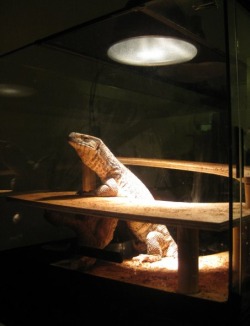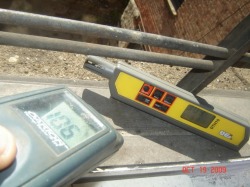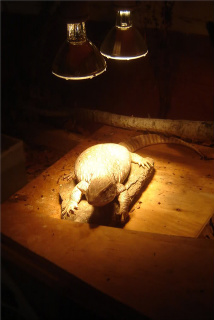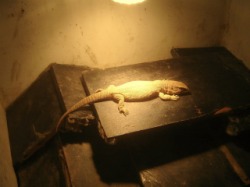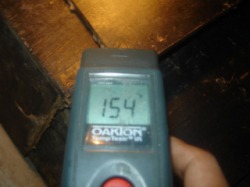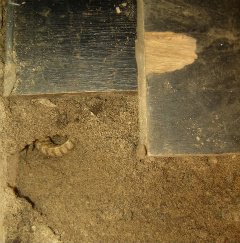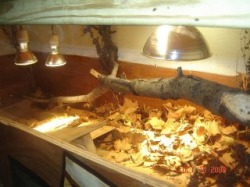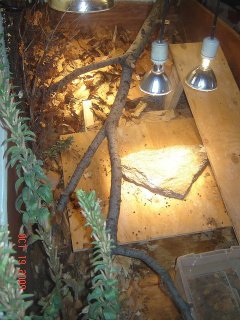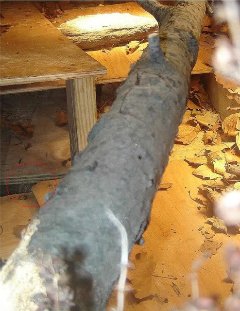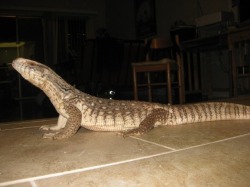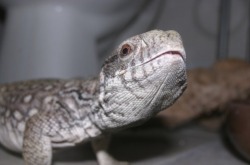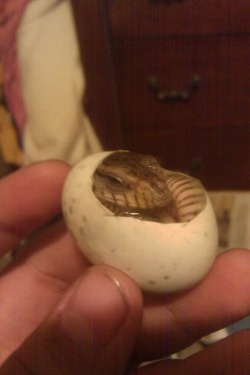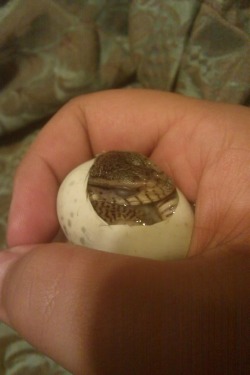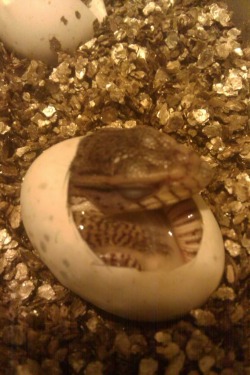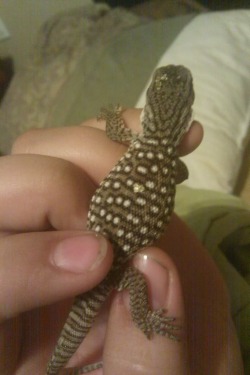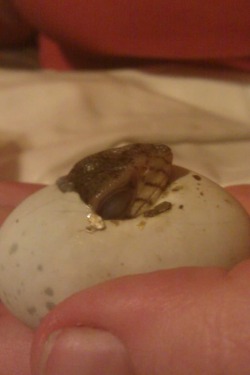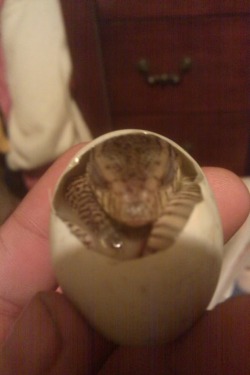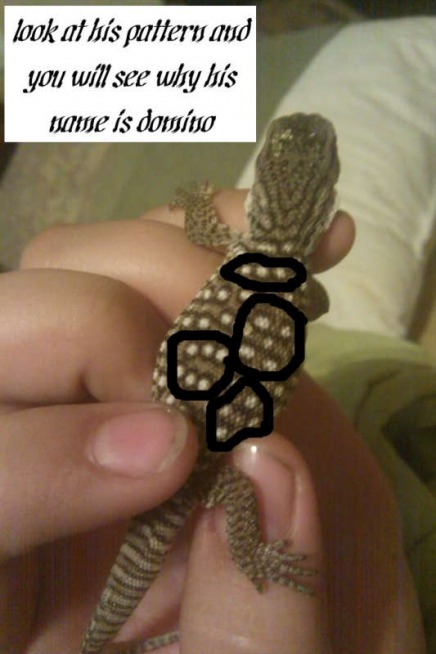PLEASE NOTE
The information on the BambooZoo site is as much as 10 years old and in the hobby much has been learned. Though, I believe there is merit in keeping the site open. There are many controversial issues presented in these pages. Please view BambooZoo as a starting point in your research.
These beings are as complicated as we are and deserve more than a basic 5 paragraph care sheet to maintain their health and well being.
My passions have evolved. This is is the site I am growing today. We Heal the World
The information on the BambooZoo site is as much as 10 years old and in the hobby much has been learned. Though, I believe there is merit in keeping the site open. There are many controversial issues presented in these pages. Please view BambooZoo as a starting point in your research.
These beings are as complicated as we are and deserve more than a basic 5 paragraph care sheet to maintain their health and well being.
My passions have evolved. This is is the site I am growing today. We Heal the World
THE SAVANNAH MONITOR
Savannah/Bosc Monitor care sheet
(Varanus exanthematicus)
WRITTEN/PHOTOS BY: JSIN AND JOHN
HOUSING
Here is a check list of what you need to properly care for a SINGLE Savannah Monitor Keep in mind these are MINIMUM requirements.
A water proof solid topped 8 x 4 x 4 enclosure for an adult and about half that for a juvenile.
2: Two feet or more of a moist, dig able soil is best. I prefer to dig up my own, but you can buy top soil and play sand from home depot or any garden center and mix it in about a 50/50 ratio if you dont have access to good silty soil in your area. If do buy from a commercial retailer such as home depot make sure the soil is not to “composty” if it has a strong musky moldy scent look for another option.
You are going to have to get your hands dirty to find the right amount of water to add. Begin by mixing equal parts of sand and top soil adding water as needs so that when you make a dirt ball in your hand it will keep its shape but still fall apart when poked with a finger. If you cannot find proper top soil you can use cypress mulch. It will retain moisture and provide adequate humidity for your Sav. however it will not hold a burrow. For this reason it is NEVER recommended for females. For females you should ALWAYS use a dirt mix. The importance of proper substrate can not be stressed enough. Cypress mulch is a very, very distant second since it will not hold a burrow but will retain a good amount of moisture . It is NEVER recommended for females. For females you should ALWAYS use a dirt mix. The importance of proper substrate can not be stressed enough.
3: A 130F-155F basking spot (Realize we are NOT talking about air temps. We are talking about the surface temperature of a SPOT in the cage. This pic. should show the difference clearly
Basking spots can be created using 45 watt halogen FLOOD lights suspended about 8"-12" over an elevated wooden surface. For Adult Savs you will need to use more then one halogen flood bulb as you want a consistent temperature area the same size as your lizard. As you want to provide varying temperature ranges for your Sav and also a sense of security "Retes" stacks are recommended (Named after the great Frank Retes of the Goanna Ranch). Here are several photos showing Retes Stacks being used. As you will notice even while hiding these Savannah Monitors are able to get access to proper temperatures.
CAUTION: when using stones or sand in a basking spot make sure that there is adequate space and provide alternate basking areas since stone/sand heats up faster and hotter then wood.
CAUTION: Note that all of the basking areas shown provide a lot of open basking space around the central heat area. This additional space allows your monitor to choose the correct distance/temperature range that it wants.
CAUTION: Note that all of the basking areas shown provide a lot of open basking space around the central heat area. This additional space allows your monitor to choose the correct distance/temperature range that it wants.
This juvenile Savannah is basking on a surface temp. of over 150F!!!!!look!!!!
4: Ambient temperatures (Air temps) should range from 85F-90F on the warm side, and dropping down to 70F on the cool. The best part of a solid topped water proof cage with deep substrate is that all the heating(basking and ambient air temps) can be achieved with just the basking flood lamps (don’t be the guy using the 150 watt super mega watt, with the screen lid and still be unable to get the right temps and humidity). In a setup like this your basking lights can be run 24/7 for providing heat and basking opportunities on the monitors schedule, not yours. However if you want a more traditional 12/12 light schedule you will need an alternative heat source such as a ceramic heat bulb for night times only. All in all the total temp range should be from 130F-155F (basking surface temp, not air temp) down to 70F+ (air temp.) during the day and air temps of 85F-70F at night (if not doing 24/7 basking).
Now here is a pic of a raise up cage of mine.
It is 4’x2’x2’ and is constructed of melamine sealed with poly vinyl. and silicone. The top is Plexiglas. The substrate is one foot of 50/50 topsoil/playsand and all heat is provided by one 45watt halogen flood set to provide a basking temp. of 125F (hatchling need to have a lower basking temp then an adult)
This pic shows very clearly the benefits of using deep dirt as a substrate
This pic shows very clearly the benefits of using deep dirt as a substrate
Now this is and adult male savannah monitor setup.
It is made from 2x4’s and plywood sealed with linoleum sheeting and LOTS of silicon. Its 8’x4’x4’ and the hinged top is plywood with plexi cut outs. Heating is done with three 60 watt floods run through rheostats creating one basking spot of 155F, a second basking spot of 130F, and a 3rd basking spot set at 120. The substrate in the pictures is 200lbs of topsoil, 200lbs of playsand and 200lbs of cypress mulch all topped with a layer of leaf litter. Again these are minimum requirements. When keeping varanids bigger caging and more choices for the lizard is always best.
FEEDING:
First and foremost feed them LOTS of bugs. Savs are naturally insectivores that DO NOT naturally prey on vertebrates in the wild and this should be replicated as much as possible in captivity.
Common feeder invertebrates include:
Crickets
Super Worms
Roaches
Locust
Silk worms
Crabs
Shrimp
Crayfish
Mussels
Snails
The list can go on and on.....
With invertebrates as the base/bulk of your Savs healthy diet you can also feed:
Snakes
Lizards
Fertile reptile/bird eggs
rodents
birds
The list can go on and on.....
The main thing to remember here is feed WHOLE PREY. No cuts of beef or chicken. No canned diets. Just feed whole animals with guts, exoskeletons, feathers, fur, teeth and bones and you can't go wrong. Juveniles should be fed as much as they want everyday while adults should be fed according to their weight. You should always be able to see your Savs lateral fold.
TAMING
This has always been a hotly debated issue in the varanid keeping community and I figured id express my point of view....................If you want to have a monitor that is fairly easy to deal with and not the typical H3LL on wheels horror story we normally hear about, LEAVE THEM THE HECK ALONE! Here’s an analogy: Let’s say you want to "tame" a wild squirrel or a wolf or a feral cat in the wild. You wouldn’t grab the squirrel / wolf / feral cat and force handle it until it gives in and likes you. You try to get it use to you by just being around first at, getting it to first tolerate your visual presence and act normally when you are within eye sight before anything else. Then eventually one day you start by tempting it closer to you with food by tossing it over to it. It probably wont happen at first (the animal will most likely just run away at first, but then at some point it will start to grab the food first and then run away to eat) but, with time, patience, and never touching it (just offering food) it will then start to eat in your presence. Eventually overtime, that damn wild animal might even sit on you or next to you and take food right from your tongs, again only if you are patient and if you NEVER, EVER TOUCH IT ! It is the same thing with monitors. By constantly handling a monitor in the hopes that it will "tame" you’re actually teaching it that you’re a NEGATIVE experience and it will hate you! But by associating positive behavior with a positive reward, like food, the animal starts seeing you in a positive light. That is how you begin the "taming" process and "tame" a monitor. Remember a "tame" monitor will still not let you just pick it up out of no where( for the most part) and handling just for the fun of it is still bad, but it will not be scared of you and will actually come to you too see what’s up (food??) And nothing is cooler then having your pet varanid beg for food or beg to be let out.
THANKS
Lastly we would like to thank all the members of the various Varanid specific forums that have helped people like me and John, turn our husbandry around and help us provide the best we can for our captives.
P.S. A very special "thank you" to Crocdoc who was the original inspiration behind the squirrel / wolf / feral cat taming analogy.
Thank you for reading
Jsin (slayer) and John (ivory0dawn)
First and foremost feed them LOTS of bugs. Savs are naturally insectivores that DO NOT naturally prey on vertebrates in the wild and this should be replicated as much as possible in captivity.
Common feeder invertebrates include:
Crickets
Super Worms
Roaches
Locust
Silk worms
Crabs
Shrimp
Crayfish
Mussels
Snails
The list can go on and on.....
With invertebrates as the base/bulk of your Savs healthy diet you can also feed:
Snakes
Lizards
Fertile reptile/bird eggs
rodents
birds
The list can go on and on.....
The main thing to remember here is feed WHOLE PREY. No cuts of beef or chicken. No canned diets. Just feed whole animals with guts, exoskeletons, feathers, fur, teeth and bones and you can't go wrong. Juveniles should be fed as much as they want everyday while adults should be fed according to their weight. You should always be able to see your Savs lateral fold.
TAMING
This has always been a hotly debated issue in the varanid keeping community and I figured id express my point of view....................If you want to have a monitor that is fairly easy to deal with and not the typical H3LL on wheels horror story we normally hear about, LEAVE THEM THE HECK ALONE! Here’s an analogy: Let’s say you want to "tame" a wild squirrel or a wolf or a feral cat in the wild. You wouldn’t grab the squirrel / wolf / feral cat and force handle it until it gives in and likes you. You try to get it use to you by just being around first at, getting it to first tolerate your visual presence and act normally when you are within eye sight before anything else. Then eventually one day you start by tempting it closer to you with food by tossing it over to it. It probably wont happen at first (the animal will most likely just run away at first, but then at some point it will start to grab the food first and then run away to eat) but, with time, patience, and never touching it (just offering food) it will then start to eat in your presence. Eventually overtime, that damn wild animal might even sit on you or next to you and take food right from your tongs, again only if you are patient and if you NEVER, EVER TOUCH IT ! It is the same thing with monitors. By constantly handling a monitor in the hopes that it will "tame" you’re actually teaching it that you’re a NEGATIVE experience and it will hate you! But by associating positive behavior with a positive reward, like food, the animal starts seeing you in a positive light. That is how you begin the "taming" process and "tame" a monitor. Remember a "tame" monitor will still not let you just pick it up out of no where( for the most part) and handling just for the fun of it is still bad, but it will not be scared of you and will actually come to you too see what’s up (food??) And nothing is cooler then having your pet varanid beg for food or beg to be let out.
THANKS
Lastly we would like to thank all the members of the various Varanid specific forums that have helped people like me and John, turn our husbandry around and help us provide the best we can for our captives.
P.S. A very special "thank you" to Crocdoc who was the original inspiration behind the squirrel / wolf / feral cat taming analogy.
Thank you for reading
Jsin (slayer) and John (ivory0dawn)
A new Savannah enters the world.
Photos by: Damian Lucas Ramiraz
INSECTS AND MONITORS ~ THE ANALYSI
CISSE,M. Bulletin de L'insitute Fondamental d'Afrique Noire. 1972 34 (2): 503-515. The diet ofVaranids in Senegal. Translated by Daniel Bennett
on page 21. Its a translated to english in the field study on the diet of Savannah and Nile monitors that proves how specialized an invert feeder Savannahs are.
http://www.kingsnake.com/aho/pdf/men...tt_undated.pdf
Heres an excerpt that cuts to the meat of it all
"In total we analysed the stomach contents of 28 animals. The results are presented by monitor
and by month in table I. The identified prey was made up exclusively of invertebrates except
for the eggs of Agama agama and V. exanthematicus. The following were found;
1. Insects.
a. Coleopera:
- Carabids: Ctenosta senegalense, Megacephala megacephela, Scarites sp.
- Curculionids: Episus sp.
- Dytiscids: Cybister sp.
- Meloids: Psalydolytta fusca.
- Scaribids: Adoretus sp. Anomala sp. Oryctes sp. Schizonycha africana.
- Tenebrionids: Pimelia senegalensis, Phrynocolus dentatus, Vieta senegalensis.
b. Dictyoptera: Mantes: Epitenodera gambiensis
c. Hymenoptera: Aphids: Xylocopa sp.
d. Lepidotera: chiefly Chenilles and Sphingids.
e. Orthoptera:
- Acridids: Acanthacris ruficornis citrina, Anacridium sp., Kraussaria angulifera, Cataloipus sp.,
Oedaleus nigeriensis, Humbe tenuicornis.
- Gryllids: Gryllus bimaculatus
- Pyrgomorphids: Zonocerus variegatus
- Tettigonids: Homorocoryphus nitidulus vicinus.
2. Arachnids: a scorpion of the family Buthidae.
3. Myriapods: Diplopodes (Iules) and Chilipods (Scolopendra).
4. Molluscs: Gasteropods pulmones Helicarionines.
5. The eggs of Varanus exanthematicus and Agama agama.
In order of number, prey was distributed as follows;
Myriapods 48.32%
Insects 45.49% of which 21.22% were Coleopterids, 15.21% Lepidoterans (Chenilles) and
8.84% Orthopterans.
Eggs of Agama and V. exanthematicus 3.75%.
Gasteropod molluscs 2.35%.
Arachnid scorpions 0.11%.
These results interpret the respective percentages of prey items, but they do not give
information on their distribution in the predators. This we have indicated by the degrees of
prescence (LESCURE). The number of animals containing each prey is given. In other words,
it shows the percentage of animals containing each prey.
Table II shows the different prey with their percentages and frequency of prescence. The prey
most frequently consumed by V. exanthematicus in the area where our research was based
was the Coleopterids (64.28%), the Myriapods (53.57%), larvae of Lepidopterans (46.42%)
and the Orthopterans (35.71%).
If we consider this diet by month we need to establish whether it reflects the availability of the
large invertebrates of that period. In fact, the Coleopterans, larvae of Sphingides and the
Myriopods, which are abundant during the first half of the winter constitute the main items of
prey during this season, whilst they are absent from the intestines towards the end of the
season, replaced at that time by the Orthopterans which become more numerous. Otherwise,
except for the reptile eggs (Agama and Varanus) we did not find any trace of vertebrates in the
diet of V.exanthematicus. This species feeds exclusively on invertebrates and eggs (including
those of its own species). Towards the end of December all feeding ceases until favourable
conditions return.
Is this diet different from that of Varanus nilocticus? This is what we are going to find byexamining the stomach contents of the second species......................"
on page 21. Its a translated to english in the field study on the diet of Savannah and Nile monitors that proves how specialized an invert feeder Savannahs are.
http://www.kingsnake.com/aho/pdf/men...tt_undated.pdf
Heres an excerpt that cuts to the meat of it all
"In total we analysed the stomach contents of 28 animals. The results are presented by monitor
and by month in table I. The identified prey was made up exclusively of invertebrates except
for the eggs of Agama agama and V. exanthematicus. The following were found;
1. Insects.
a. Coleopera:
- Carabids: Ctenosta senegalense, Megacephala megacephela, Scarites sp.
- Curculionids: Episus sp.
- Dytiscids: Cybister sp.
- Meloids: Psalydolytta fusca.
- Scaribids: Adoretus sp. Anomala sp. Oryctes sp. Schizonycha africana.
- Tenebrionids: Pimelia senegalensis, Phrynocolus dentatus, Vieta senegalensis.
b. Dictyoptera: Mantes: Epitenodera gambiensis
c. Hymenoptera: Aphids: Xylocopa sp.
d. Lepidotera: chiefly Chenilles and Sphingids.
e. Orthoptera:
- Acridids: Acanthacris ruficornis citrina, Anacridium sp., Kraussaria angulifera, Cataloipus sp.,
Oedaleus nigeriensis, Humbe tenuicornis.
- Gryllids: Gryllus bimaculatus
- Pyrgomorphids: Zonocerus variegatus
- Tettigonids: Homorocoryphus nitidulus vicinus.
2. Arachnids: a scorpion of the family Buthidae.
3. Myriapods: Diplopodes (Iules) and Chilipods (Scolopendra).
4. Molluscs: Gasteropods pulmones Helicarionines.
5. The eggs of Varanus exanthematicus and Agama agama.
In order of number, prey was distributed as follows;
Myriapods 48.32%
Insects 45.49% of which 21.22% were Coleopterids, 15.21% Lepidoterans (Chenilles) and
8.84% Orthopterans.
Eggs of Agama and V. exanthematicus 3.75%.
Gasteropod molluscs 2.35%.
Arachnid scorpions 0.11%.
These results interpret the respective percentages of prey items, but they do not give
information on their distribution in the predators. This we have indicated by the degrees of
prescence (LESCURE). The number of animals containing each prey is given. In other words,
it shows the percentage of animals containing each prey.
Table II shows the different prey with their percentages and frequency of prescence. The prey
most frequently consumed by V. exanthematicus in the area where our research was based
was the Coleopterids (64.28%), the Myriapods (53.57%), larvae of Lepidopterans (46.42%)
and the Orthopterans (35.71%).
If we consider this diet by month we need to establish whether it reflects the availability of the
large invertebrates of that period. In fact, the Coleopterans, larvae of Sphingides and the
Myriopods, which are abundant during the first half of the winter constitute the main items of
prey during this season, whilst they are absent from the intestines towards the end of the
season, replaced at that time by the Orthopterans which become more numerous. Otherwise,
except for the reptile eggs (Agama and Varanus) we did not find any trace of vertebrates in the
diet of V.exanthematicus. This species feeds exclusively on invertebrates and eggs (including
those of its own species). Towards the end of December all feeding ceases until favourable
conditions return.
Is this diet different from that of Varanus nilocticus? This is what we are going to find byexamining the stomach contents of the second species......................"
TRANSLATED FOR US LOWER LIFE FORMS
1. Insects.
a. Coleopera:
- Carabids: Ctenosta senegalense, Megacephala megacephela, Scarites sp.......................... ( Ground beetles)
- Curculionids: Episus sp......................................... ( Weevles)
- Dytiscids: Cybister sp............................................ ( Water beetles)
- Meloids: Psalydolytta fusca.................................. ( Blister beetles)
- Scaribids: Adoretus sp. Anomala sp. Oryctes sp. Schizonycha africana ............................ (Scarab Beetles)
- Tenebrionids: Pimelia senegalensis, Phrynocolus dentatus, Vieta senegalensis............................. (Darkling Beetles)
b. Dictyoptera: Mantes: Epitenodera gambiensis.......................................... ( Mantids)
c. Hymenoptera: Aphids: Xylocopa sp............................................. ( Carpenter bees )
d. Lepidotera: chiefly Chenilles and Sphingids................................ ( Moths)
e. Orthoptera:
- Acridids: Acanthacris ruficornis citrina, Anacridium sp., Kraussaria angulifera, Cataloipus sp.,
Oedaleus nigeriensis, Humbe tenuicornis.............................................. ( Locusts)
- Gryllids: Gryllus bimaculatus................................ (Field Crickets)
- Pyrgomorphids: Zonocerus variegatus................................... ( Grasshopper)
- Tettigonids: Homorocoryphus nitidulus vicinus.................................... ( African Bush Cricket)
2. Arachnids: a scorpion of the family Buthidae.
3. Myriapods: Diplopodes (Iules) and Chilipods (Scolopendra)................................... (Millipedes and Centipedes)
4. Molluscs: Gasteropods pulmones Helicarionines....................................... (Snails)
5. The eggs of Varanus exanthematicus and Agama agama
I tried to do roaches for a while and well... she would eat about a whole colony in one sitting
It shouldn't be that bad, especially if you are feeding appropriately sized roaches. My adult will eat 5-7 adult Blaberus Cranifers every other day and he'll still get fat... granted he will also act like he's starved. But belly and tail size count more then open mouths scratching at the glass when the screen door opens.
You can set up a colony pretty easily and cheaply... once you have a good mix of roaches going you then feed from the generation that is appropriate to your monitors size. Usually not bigger then the distance between the monitors eyes... though with that said mine will also eat snails bigger then his head.
Here is a link to how I keep my roaches for my Sav and other critters. http://www.reptileforums.net/forums/...er-Roach-Setup
If someone could come up with a diet maybe consisting of shellfish and stuff(Ive heard shrimp need to be used sparingly??) Ultimately the most cost effective and healthy option is Roaches. They should be the bulk of his diet. From there as a juvenile you can substitute crickets, earth worms, super worms, locust, darkling beetles... they will eat it all... as he gets bigger you can start adding in land snails, aquatic snails, clams, oysters, WHOLE shrimp (i.e. shell, guts, head... alll of it.), crab, ... But again those are adult food items and should still be fed in a sparing manner. Mine usually gets an alternative food item feeding once a week. So for example all week I have feed roaches but last night I did one whole feeding with a large sea snail.
As for feeding the hard shelled prey, your sav will develop special teeth for that when it matures. I use to worry about it a lot before I started doing it but as an adult hard shells aren't a problem for a Sav's teeth and claws. Watching him crush those shells I reealize how happy I am that he never tries to bite, and that I should never drop my guard. I don't think my bones are ass tough as some of the shells.
JOHN WILSON
OTHER SITES OF INTEREST
The Biawak journal published by the INTERNATIONAL VARANID INTEREST GROUP
"Biawak is the official peer-reviewed journal of the IVIG. Published quarterly, Biawak publishes original articles and notes which pertain to the biology and captive husbandry of monitor lizards, as well as book reviews, historical accounts, veterinary reports, innovative techniques, bibliographies, commentaries, translations, and digests of current varanid research".
All issues can be located here
http://varanidae.org/biawak
The Varanid Information Network
This is the personal forum of herpticultural pioneer Frank Retes. This cranky old man is by far the most accomplished varanid keeper/breeder the world over and is an incredible wealth of information and is your go to place for receiving the best info on the subject of captive breeding varanids.
http://www.varanus.net/
The RepticZone monitor forum
This forum is a perfect one for new keepers of and those interested in keeping varanids.
http://www.repticzone.com/forums/Monitors/index.html
Mampam Conservation
A varanid(as well as many other species)conservation site filled with LOTS of info on varanids in the wild.
http://www.mampam.com/
Kingsnake.com's Varanid forum
Another good varanid forum for newer keepers with an AMAZING wealth of info hidden in the archives. USE THE SEARCH FUNCTION.
http://forums.kingsnake.com/forum.php?catid=55
Savannahmonitor.org
With the most up to date information on the captive care of the Savannah Monitor, this site is a must have in every varanid enthusiast Favorites Folder.
http://savannahmonitor.org/
Our appreciation for your contribution to the Bamboozoo.
Jsin (slayer) and John (ivory0dawn) www.reptileforums.net
The Biawak journal published by the INTERNATIONAL VARANID INTEREST GROUP
"Biawak is the official peer-reviewed journal of the IVIG. Published quarterly, Biawak publishes original articles and notes which pertain to the biology and captive husbandry of monitor lizards, as well as book reviews, historical accounts, veterinary reports, innovative techniques, bibliographies, commentaries, translations, and digests of current varanid research".
All issues can be located here
http://varanidae.org/biawak
The Varanid Information Network
This is the personal forum of herpticultural pioneer Frank Retes. This cranky old man is by far the most accomplished varanid keeper/breeder the world over and is an incredible wealth of information and is your go to place for receiving the best info on the subject of captive breeding varanids.
http://www.varanus.net/
The RepticZone monitor forum
This forum is a perfect one for new keepers of and those interested in keeping varanids.
http://www.repticzone.com/forums/Monitors/index.html
Mampam Conservation
A varanid(as well as many other species)conservation site filled with LOTS of info on varanids in the wild.
http://www.mampam.com/
Kingsnake.com's Varanid forum
Another good varanid forum for newer keepers with an AMAZING wealth of info hidden in the archives. USE THE SEARCH FUNCTION.
http://forums.kingsnake.com/forum.php?catid=55
Savannahmonitor.org
With the most up to date information on the captive care of the Savannah Monitor, this site is a must have in every varanid enthusiast Favorites Folder.
http://savannahmonitor.org/
Our appreciation for your contribution to the Bamboozoo.
Jsin (slayer) and John (ivory0dawn) www.reptileforums.net
PDF Files for Savannah/Bosc Monitors and others.
Observations on Bosc's Monitor Lizard (V. exanthematicus) in the Wild, Davind Bennett, 2000
http://library.mampam.com/bennettbullchicherpsoc.pdf
Checklist of the living monitor lizards of the world, Wolfgang Bohme
http://www.cites.org/common/cop/12/esf12i-06a.pdf
Digestive state influences the heart rate hysteresis and rates of heat exchange in varanid lizard (Varanus rosenbergi, T. D. Clark, P. J. Butler, P. B. Frappell, 2005
http://jeb.biologists.org/content/20....full.pdf+html
Strain Gauge Measurement of Mesokinetic Movement in the Lizard Varanus Exanthematicus, Kathleen Smith and William Hylander, 1985
http://jeb.biologists.org/content/114/1/53.full.pdf
Prey Processing in lizards: behavioral variations in sit-and-wait and widely foraging taxa, Lance McBrayer and Stephen Reilly, 2002
http://www.bio.georgiasouthern.edu/b...ly02%20CJZ.pdf
Ecological and evolutionary implications of diet in monitor lizards, Jonathan Losos and Harry Greene, 1988
http://www.oeb.harvard.edu/faculty/l...greene1988.pdf
Monitor Lizards: a pan-African check-list of their zoogeography (Sauria: Varanidea Polydaedalus), Mark Bayless, 2002
http://ipac.kacst.edu.sa/eDoc/eBook/268.pdf
Metabolic and blood gas dependence on digestive state in the Savannah Monitor lizard Varanus exanthematicus; an assessment of the alkaline tide, L. K. Hartzler, S. L. Munns, A. F. Bennett and J. W. Hicks, 2006
http://pubget.com/paper/16513931
Ventricular Haemodynamics in the monitor lizard Varanus Exanthematicus: Pulmonary and Systemic Pressure Separation, Warren Burggren and Kjell Johansen, 1982
http://www.biol.unt.edu/~burggren/PDFs/1982/%2833%29Burggren,Johansen1982JEB.pdf
Patterns of Cardiovascular and Ventilatory Responce to Elevated Metabolic States in the Lizard Varanus Exanthematicus. J. W. Hicks, Tobias Wang, Albert Bennett, 2000
http://jeb.biologists.org/content/203/16/2437.full.pdf
Elevated intra-abdominal pressure limits venous return during exercise in Varanus exanthematicus, SUzanne Munns, Lynn Hartzler, Albert Bennett, James Hicks, 2004
http://jeb.biologists.org/content/20....full.pdf+html
Chronic electrical stimulation drives mitochondrial biogenesis in skeletal muscle of a lizard, Varanus exanthematicus, Paul Scheaffer, Scott Nichols, Stan Lindstedt, 2007
http://jeb.biologists.org/content/21....full.pdf+html
Energetic Cost of Running With Different Muscle Temperatures in Savannah Monitor Lizards, Lawrence Rome, 1982
http://jeb.biologists.org/content/99/1/269.full.pdf
The Mechanism Of Intracardiac Shunting In The Lizard Varanus Exanthematicus, N. Heisler, P. Neumann and G. M. O. Maloiy, 1983
http://jeb.biologists.org/content/105/1/15.full.pdf
State of Biodiversity: Western Cape Province, South Africa Amphibians and Reptiles, Ernst H. W. Baard and Atherton L. de Villiers, 2000
http://docs.google.com/viewer?a=v&q=...E8ujjJEelyl7FA
Parasitisation and Localisation of ticks (ACARI: IXODIDA) on exotic reptiles imported int o Poland, Magdalena Nowak, 2010
http://www.aaem.pl/pdf/17237.pdf
Observations on Bosc's Monitor Lizard (V. exanthematicus) in the Wild, Davind Bennett, 2000
http://library.mampam.com/bennettbullchicherpsoc.pdf
Checklist of the living monitor lizards of the world, Wolfgang Bohme
http://www.cites.org/common/cop/12/esf12i-06a.pdf
Digestive state influences the heart rate hysteresis and rates of heat exchange in varanid lizard (Varanus rosenbergi, T. D. Clark, P. J. Butler, P. B. Frappell, 2005
http://jeb.biologists.org/content/20....full.pdf+html
Strain Gauge Measurement of Mesokinetic Movement in the Lizard Varanus Exanthematicus, Kathleen Smith and William Hylander, 1985
http://jeb.biologists.org/content/114/1/53.full.pdf
Prey Processing in lizards: behavioral variations in sit-and-wait and widely foraging taxa, Lance McBrayer and Stephen Reilly, 2002
http://www.bio.georgiasouthern.edu/b...ly02%20CJZ.pdf
Ecological and evolutionary implications of diet in monitor lizards, Jonathan Losos and Harry Greene, 1988
http://www.oeb.harvard.edu/faculty/l...greene1988.pdf
Monitor Lizards: a pan-African check-list of their zoogeography (Sauria: Varanidea Polydaedalus), Mark Bayless, 2002
http://ipac.kacst.edu.sa/eDoc/eBook/268.pdf
Metabolic and blood gas dependence on digestive state in the Savannah Monitor lizard Varanus exanthematicus; an assessment of the alkaline tide, L. K. Hartzler, S. L. Munns, A. F. Bennett and J. W. Hicks, 2006
http://pubget.com/paper/16513931
Ventricular Haemodynamics in the monitor lizard Varanus Exanthematicus: Pulmonary and Systemic Pressure Separation, Warren Burggren and Kjell Johansen, 1982
http://www.biol.unt.edu/~burggren/PDFs/1982/%2833%29Burggren,Johansen1982JEB.pdf
Patterns of Cardiovascular and Ventilatory Responce to Elevated Metabolic States in the Lizard Varanus Exanthematicus. J. W. Hicks, Tobias Wang, Albert Bennett, 2000
http://jeb.biologists.org/content/203/16/2437.full.pdf
Elevated intra-abdominal pressure limits venous return during exercise in Varanus exanthematicus, SUzanne Munns, Lynn Hartzler, Albert Bennett, James Hicks, 2004
http://jeb.biologists.org/content/20....full.pdf+html
Chronic electrical stimulation drives mitochondrial biogenesis in skeletal muscle of a lizard, Varanus exanthematicus, Paul Scheaffer, Scott Nichols, Stan Lindstedt, 2007
http://jeb.biologists.org/content/21....full.pdf+html
Energetic Cost of Running With Different Muscle Temperatures in Savannah Monitor Lizards, Lawrence Rome, 1982
http://jeb.biologists.org/content/99/1/269.full.pdf
The Mechanism Of Intracardiac Shunting In The Lizard Varanus Exanthematicus, N. Heisler, P. Neumann and G. M. O. Maloiy, 1983
http://jeb.biologists.org/content/105/1/15.full.pdf
State of Biodiversity: Western Cape Province, South Africa Amphibians and Reptiles, Ernst H. W. Baard and Atherton L. de Villiers, 2000
http://docs.google.com/viewer?a=v&q=...E8ujjJEelyl7FA
Parasitisation and Localisation of ticks (ACARI: IXODIDA) on exotic reptiles imported int o Poland, Magdalena Nowak, 2010
http://www.aaem.pl/pdf/17237.pdf
